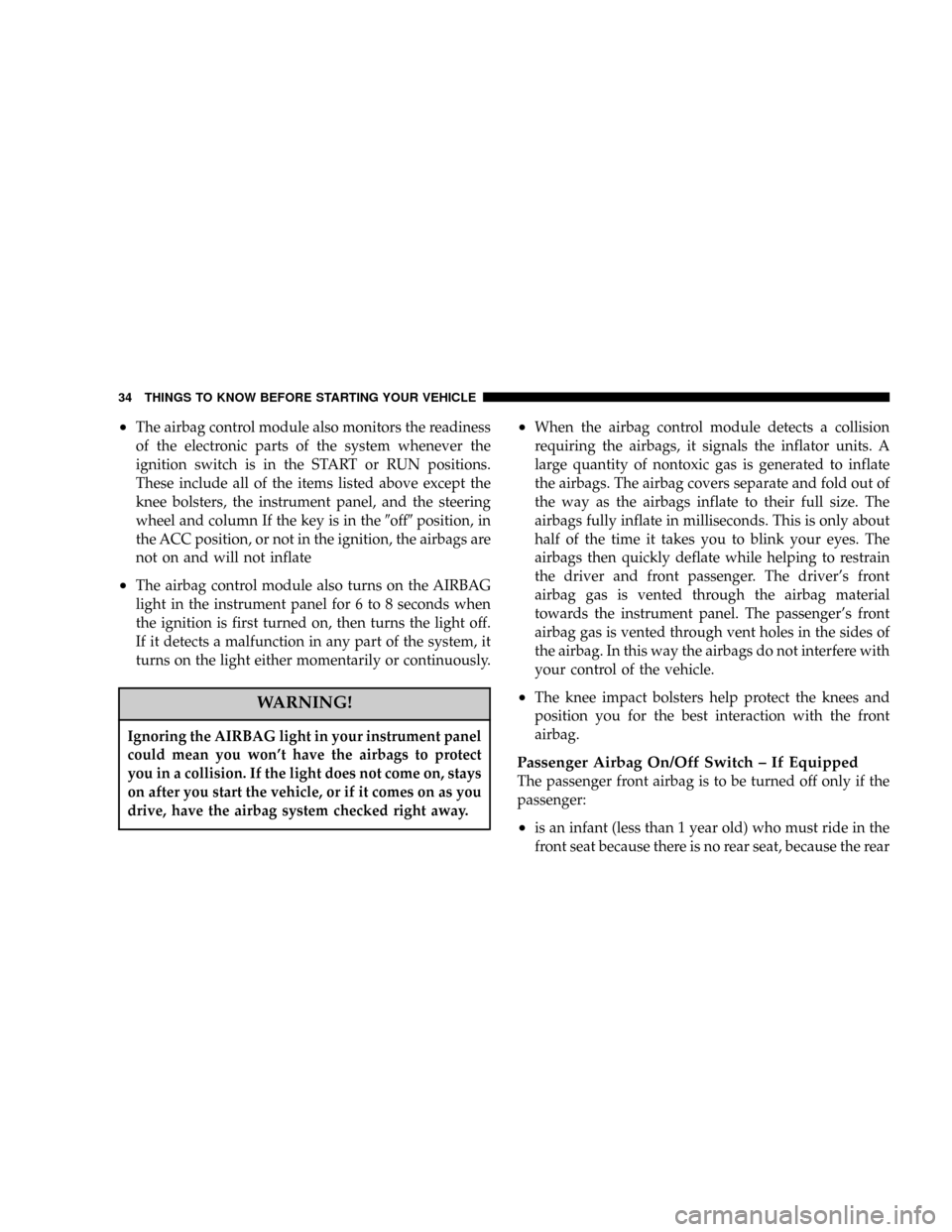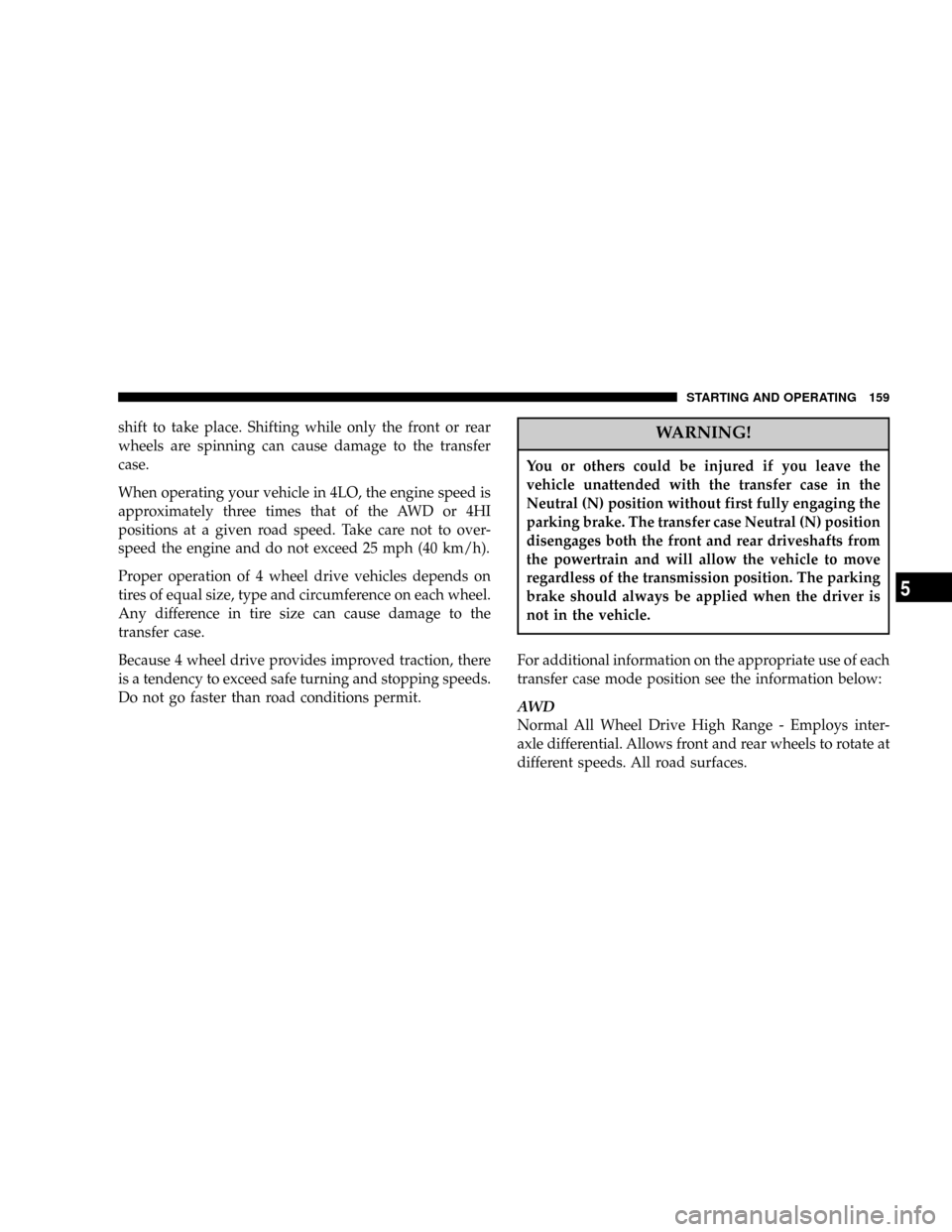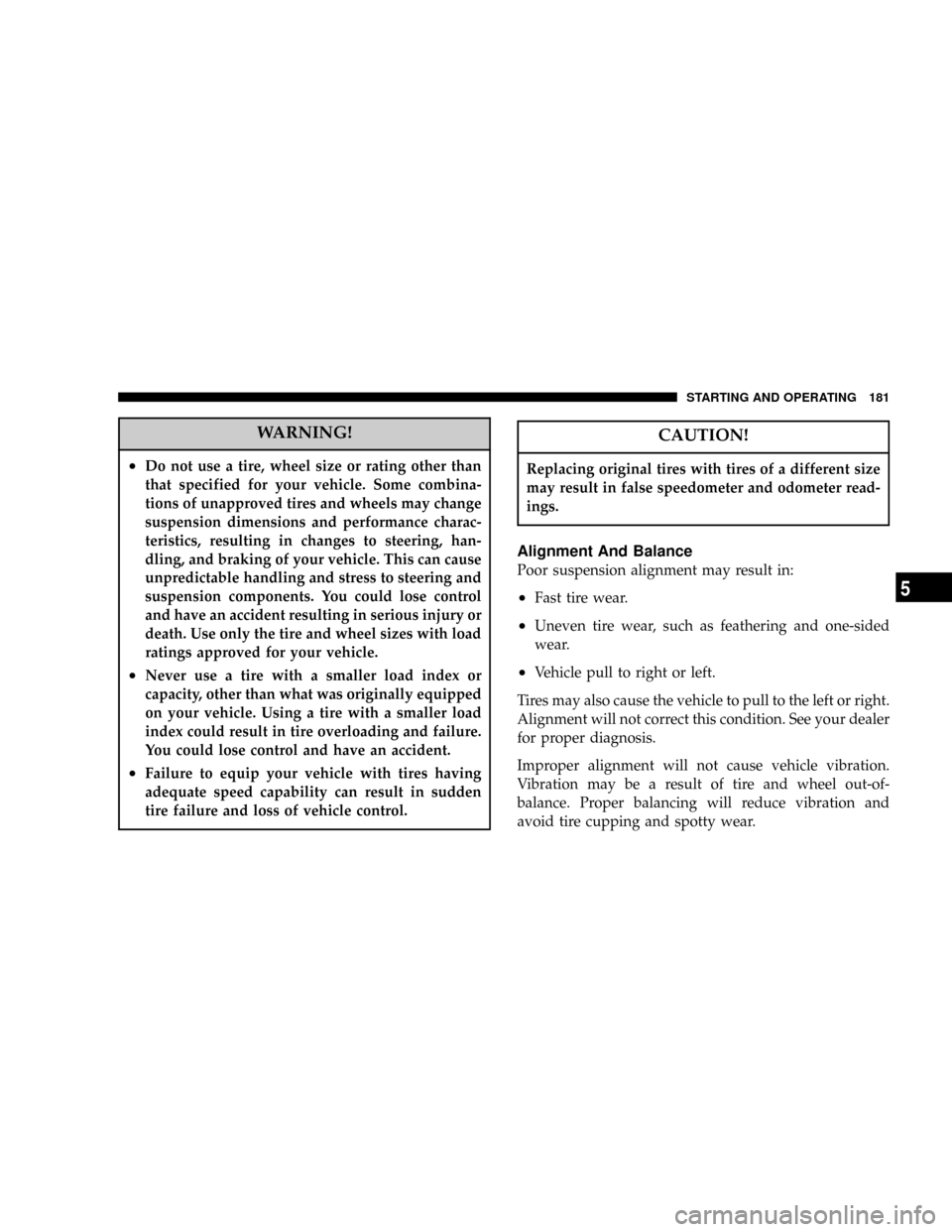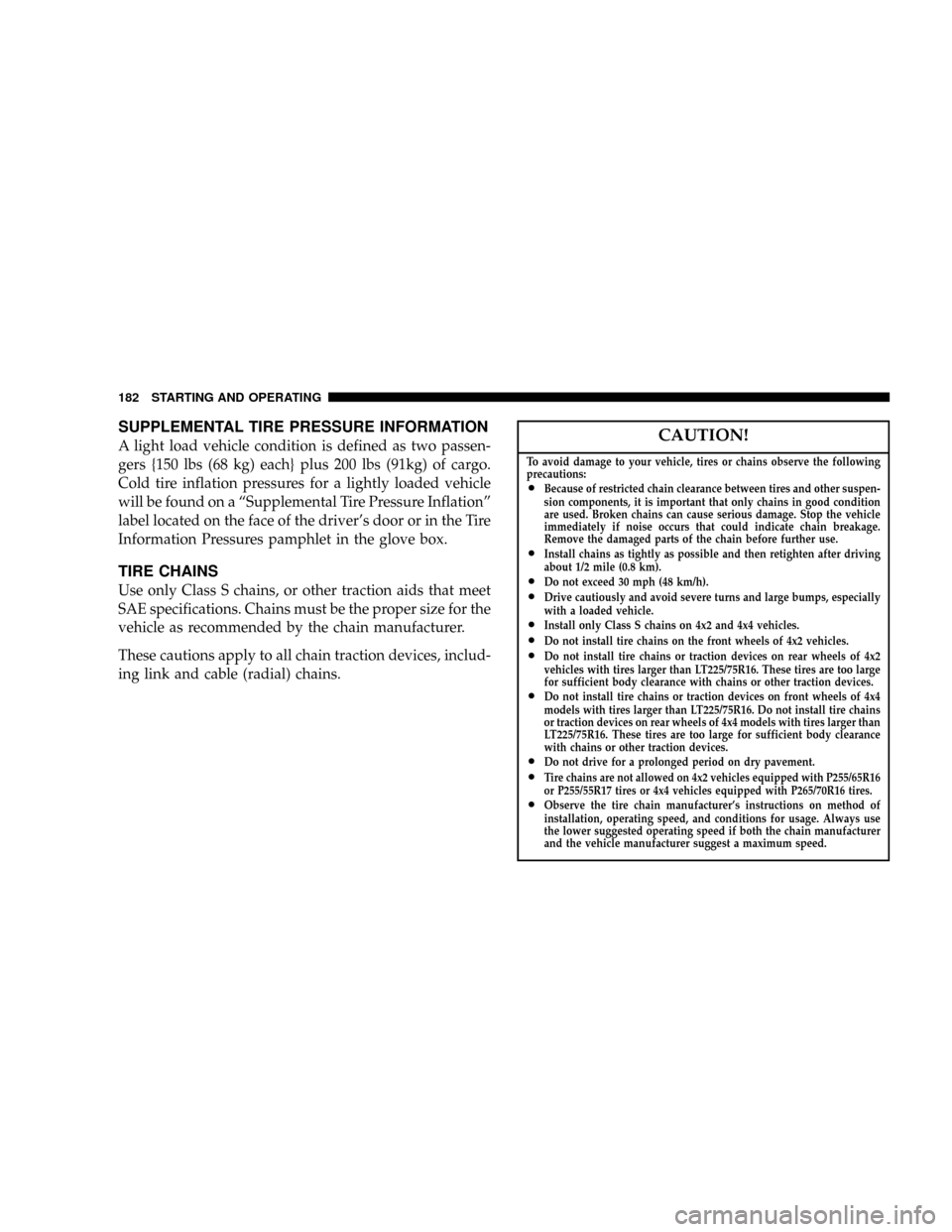2004 DODGE DAKOTA wheel size
[x] Cancel search: wheel sizePage 34 of 300

²The airbag control module also monitors the readiness
of the electronic parts of the system whenever the
ignition switch is in the START or RUN positions.
These include all of the items listed above except the
knee bolsters, the instrument panel, and the steering
wheel and column If the key is in the9off9position, in
the ACC position, or not in the ignition, the airbags are
not on and will not inflate
²The airbag control module also turns on the AIRBAG
light in the instrument panel for 6 to 8 seconds when
the ignition is first turned on, then turns the light off.
If it detects a malfunction in any part of the system, it
turns on the light either momentarily or continuously.
WARNING!
Ignoring the AIRBAG light in your instrument panel
could mean you won't have the airbags to protect
you in a collision. If the light does not come on, stays
on after you start the vehicle, or if it comes on as you
drive, have the airbag system checked right away.
²When the airbag control module detects a collision
requiring the airbags, it signals the inflator units. A
large quantity of nontoxic gas is generated to inflate
the airbags. The airbag covers separate and fold out of
the way as the airbags inflate to their full size. The
airbags fully inflate in milliseconds. This is only about
half of the time it takes you to blink your eyes. The
airbags then quickly deflate while helping to restrain
the driver and front passenger. The driver's front
airbag gas is vented through the airbag material
towards the instrument panel. The passenger's front
airbag gas is vented through vent holes in the sides of
the airbag. In this way the airbags do not interfere with
your control of the vehicle.
²The knee impact bolsters help protect the knees and
position you for the best interaction with the front
airbag.
Passenger Airbag On/Off Switch ± If Equipped
The passenger front airbag is to be turned off only if the
passenger:
²is an infant (less than 1 year old) who must ride in the
front seat because there is no rear seat, because the rear
34 THINGS TO KNOW BEFORE STARTING YOUR VEHICLE
Page 153 of 300

seconds, and retry selection. To find the shift require-
ments, refer to the9Shifting Procedure9for your transfer
case, located in this section of the owner's manual.
The ªSERVICE 4WDº warning light monitors the electric
shift 4WD system. If this light remains on after engine
start up or illuminates during driving, it means that the
4WD system is not functioning properly and that service
is required.
WARNING!
Always engage the parking brake when powering
down the vehicle if the(Service 4WD(light is
illuminated. Not engaging the parking brake may
allow the vehicle to roll which may cause personal
injury.
NOTE:Do not attempt to make a shift while only the
front or rear wheels are spinning. The NV233 transfer
case is not equipped with a synchronizer and therefore
the front and rear driveshaft speeds must be equal for the
shift to take place. Shifting while only the front or rear
wheels are spinning can cause damage to the transfer
case.
When operating your vehicle in 4LO, the engine speed is
approximately three times that of the 2WD or 4HI
positions at a given road speed. Take care not to over-
speed the engine and do not exceed 25 mph (40 km/h).
Proper operation of 4 wheel drive vehicles depends on
tires of equal size, type and circumference on each wheel.
Any difference in tire size can cause damage to the
transfer case.
Because 4 wheel drive provides improved traction, there
is a tendency to exceed safe turning and stopping speeds.
Do not go faster than road conditions permit.
STARTING AND OPERATING 153
5
Page 159 of 300

shift to take place. Shifting while only the front or rear
wheels are spinning can cause damage to the transfer
case.
When operating your vehicle in 4LO, the engine speed is
approximately three times that of the AWD or 4HI
positions at a given road speed. Take care not to over-
speed the engine and do not exceed 25 mph (40 km/h).
Proper operation of 4 wheel drive vehicles depends on
tires of equal size, type and circumference on each wheel.
Any difference in tire size can cause damage to the
transfer case.
Because 4 wheel drive provides improved traction, there
is a tendency to exceed safe turning and stopping speeds.
Do not go faster than road conditions permit.WARNING!
You or others could be injured if you leave the
vehicle unattended with the transfer case in the
Neutral (N) position without first fully engaging the
parking brake. The transfer case Neutral (N) position
disengages both the front and rear driveshafts from
the powertrain and will allow the vehicle to move
regardless of the transmission position. The parking
brake should always be applied when the driver is
not in the vehicle.
For additional information on the appropriate use of each
transfer case mode position see the information below:
AW D
Normal All Wheel Drive High Range - Employs inter-
axle differential. Allows front and rear wheels to rotate at
different speeds. All road surfaces.
STARTING AND OPERATING 159
5
Page 181 of 300

WARNING!
²Do not use a tire, wheel size or rating other than
that specified for your vehicle. Some combina-
tions of unapproved tires and wheels may change
suspension dimensions and performance charac-
teristics, resulting in changes to steering, han-
dling, and braking of your vehicle. This can cause
unpredictable handling and stress to steering and
suspension components. You could lose control
and have an accident resulting in serious injury or
death. Use only the tire and wheel sizes with load
ratings approved for your vehicle.
²Never use a tire with a smaller load index or
capacity, other than what was originally equipped
on your vehicle. Using a tire with a smaller load
index could result in tire overloading and failure.
You could lose control and have an accident.
²Failure to equip your vehicle with tires having
adequate speed capability can result in sudden
tire failure and loss of vehicle control.
CAUTION!
Replacing original tires with tires of a different size
may result in false speedometer and odometer read-
ings.
Alignment And Balance
Poor suspension alignment may result in:
²Fast tire wear.
²Uneven tire wear, such as feathering and one-sided
wear.
²Vehicle pull to right or left.
Tires may also cause the vehicle to pull to the left or right.
Alignment will not correct this condition. See your dealer
for proper diagnosis.
Improper alignment will not cause vehicle vibration.
Vibration may be a result of tire and wheel out-of-
balance. Proper balancing will reduce vibration and
avoid tire cupping and spotty wear.
STARTING AND OPERATING 181
5
Page 182 of 300

SUPPLEMENTAL TIRE PRESSURE INFORMATION
A light load vehicle condition is defined as two passen-
gers {150 lbs (68 kg) each} plus 200 lbs (91kg) of cargo.
Cold tire inflation pressures for a lightly loaded vehicle
will be found on a ªSupplemental Tire Pressure Inflationº
label located on the face of the driver's door or in the Tire
Information Pressures pamphlet in the glove box.
TIRE CHAINS
Use only Class S chains, or other traction aids that meet
SAE specifications. Chains must be the proper size for the
vehicle as recommended by the chain manufacturer.
These cautions apply to all chain traction devices, includ-
ing link and cable (radial) chains.
CAUTION!
To avoid damage to your vehicle, tires or chains observe the following
precautions:
²Because of restricted chain clearance between tires and other suspen-
sion components, it is important that only chains in good condition
are used. Broken chains can cause serious damage. Stop the vehicle
immediately if noise occurs that could indicate chain breakage.
Remove the damaged parts of the chain before further use.
²Install chains as tightly as possible and then retighten after driving
about 1/2 mile (0.8 km).
²Do not exceed 30 mph (48 km/h).²Drive cautiously and avoid severe turns and large bumps, especially
with a loaded vehicle.
²Install only Class S chains on 4x2 and 4x4 vehicles.²Do not install tire chains on the front wheels of 4x2 vehicles.²Do not install tire chains or traction devices on rear wheels of 4x2
vehicles with tires larger than LT225/75R16. These tires are too large
for sufficient body clearance with chains or other traction devices.
²Do not install tire chains or traction devices on front wheels of 4x4
models with tires larger than LT225/75R16. Do not install tire chains
or traction devices on rear wheels of 4x4 models with tires larger than
LT225/75R16. These tires are too large for sufficient body clearance
with chains or other traction devices.
²Do not drive for a prolonged period on dry pavement.²Tire chains are not allowed on 4x2 vehicles equipped with P255/65R16
or P255/55R17 tires or 4x4 vehicles equipped with P265/70R16 tires.
²Observe the tire chain manufacturer's instructions on method of
installation, operating speed, and conditions for usage. Always use
the lower suggested operating speed if both the chain manufacturer
and the vehicle manufacturer suggest a maximum speed.
182 STARTING AND OPERATING
Page 199 of 300
![DODGE DAKOTA 2004 3.G Owners Manual 2.GTW
3.Tongue weight rating for the trailer hitch uti-
lized (This requirement may limit the ability to
always achieve the 10% to 15% range of tongue
weight [15% to 25% for a(5th Wheel(style trailer] DODGE DAKOTA 2004 3.G Owners Manual 2.GTW
3.Tongue weight rating for the trailer hitch uti-
lized (This requirement may limit the ability to
always achieve the 10% to 15% range of tongue
weight [15% to 25% for a(5th Wheel(style trailer]](/manual-img/12/5586/w960_5586-198.png)
2.GTW
3.Tongue weight rating for the trailer hitch uti-
lized (This requirement may limit the ability to
always achieve the 10% to 15% range of tongue
weight [15% to 25% for a(5th Wheel(style trailer]
as a percentage of total trailer weight.)
4.GAWR ratings
NOTE:
Towing a trailer equipped with more than the
standard lighting (turn, tail, stop and backup lights) may
cause an abnormally high electrical current draw through
the headlight switch, causing the switch to fail. To
prevent a recurring switch failure install a trailer tow
wiring harness overlay kit with relay to bypass headlight
switch (available from your dealer).
Trailer Towing Information (Maximum Trailer
Weight Ratings)
(Trailer Towing Guide(
NOTE:
For trailer towing information (maximum
trailer weight ratings) refer to the following website
address:http:// www.dodge.com/towing.
In Canada, refer to the following website address:
http:// www.dodge.ca.
Trailer Towing Requirements
All Dodge Dakota trucks are intended to tow trailers up
to 2,000 lbs. without added equipment or alterations to
standard equipment. Your vehicle may be factory
equipped for safe towing of trailers weighing over 2,000
lbs. with the Trailer Tow Package. The electrical part of
this package includes an instruction sheet, a 7/4 pin
adaptor, a wiring pigtail for an aftermarket electric trailer
brake controller, and three relays that must be installed
into the power distribution center. These items are stored
in the glove box. Also included in the Trailer Tow
Package are two fuses and a relay that are located on the
driver's side of the engine compartment on a harness
near the Power Distribution Center. This relay and the
fuses power up the trailer towing option. See your Dodge
dealer for further information.
If you regularly pull a trailer, regardless of the trailer size,
stop and turn signals on the trailer are recommended for
motoring safety. To handle the additional electrical load
STARTING AND OPERATING 199
5
Page 299 of 300

Tires ..............................54,175
Air Pressure......................... 175
Alignment.......................... 181
Chains............................. 182
Changing........................... 209
Compact Spare....................... 178
General Information................... 175
High Speed......................... 177
Inflation Pressures.................... 176
Jacking............................. 211
Load Capacity....................... 172
Radial............................. 178
Replacement......................... 180
Rotation.........................183,264
Safety...........................167,175
Sizes............................... 169
Snow Tires.......................... 183
Spare Tire........................... 210
Spinning............................ 179
Tread Wear Indicators.................. 180
Warnings........................... 182
Wheel Nut Torque.................... 213
Tongue Weight/Trailer Weight............. 197Torque Converter Clutch................. 149
Towing
Disabled Vehicle...................... 217
Guide.............................. 199
Recreational......................... 202
Trailering........................... 195
Weight............................. 199
Traction.............................. 206
Trailer Towing......................... 195
Cooling System Tips................... 201
Hitches............................. 198
Minimum Requirements................ 199
Trailer and Tongue Weight.............. 197
Wiring............................. 200
Trailer Towing Guide.................... 199
Trailer Weight......................... 199
Transfer Case.......................... 248
Fluid.............................. 260
Transmission....................146,150,245
Automatic.....................144,146,245
Filter.............................. 247
Fluid........................245,247,260
Manual.......................144,150,245
INDEX 299
10